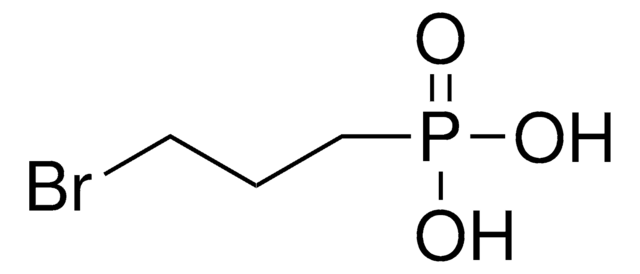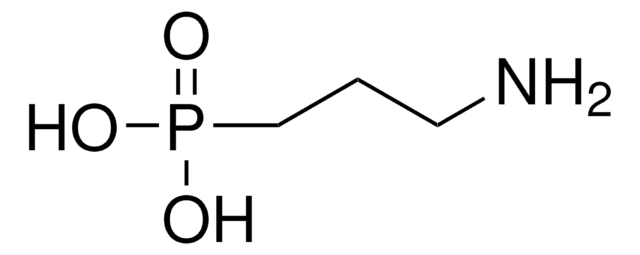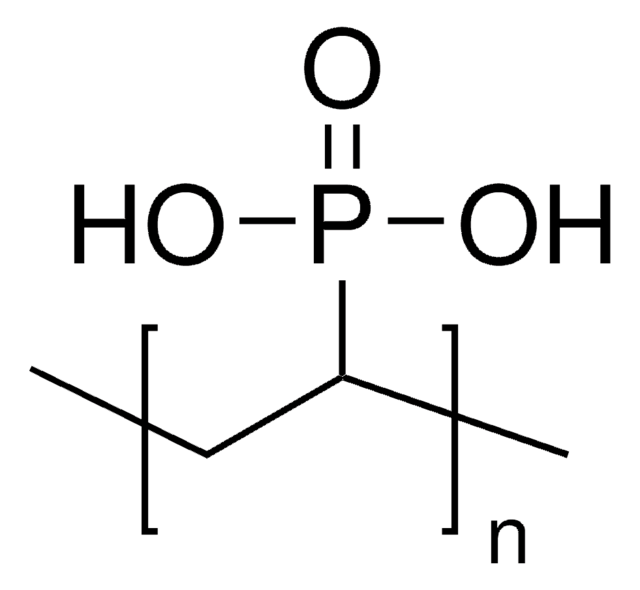Wszystkie zdjęcia(3)
Key Documents
745855
12-Mercaptododecylphosphonic acid
95%
Synonim(y):
P-(12-Mercaptododecyl)phosphonic acid
Zaloguj sięWyświetlanie cen organizacyjnych i kontraktowych
About This Item
Wzór empiryczny (zapis Hilla):
C12H27O3PS
Numer CAS:
Masa cząsteczkowa:
282.38
Numer MDL:
Kod UNSPSC:
12352103
Identyfikator substancji w PubChem:
NACRES:
NA.23
Polecane produkty
Poziom jakości
Próba
95%
Postać
powder
mp
92-96 °C
temp. przechowywania
2-8°C
ciąg SMILES
OP(O)(CCCCCCCCCCCCS)=O
InChI
1S/C12H27O3PS/c13-16(14,15)11-9-7-5-3-1-2-4-6-8-10-12-17/h17H,1-12H2,(H2,13,14,15)
Klucz InChI
PVIUMTORLYKRJT-UHFFFAOYSA-N
Opis ogólny
12-Mercaptododecylphosphonic acid (MDPA) is an organophosphonic acid that forms a self-assembled monolayer (SAM). The phosphonic groups tend to react with the metal surfaces that allow the formation of metal-oxygen-phosphonate (M-O-P) bonds that facilitate the surface with mechanical and chemical stability.
Zastosowanie
MDPA based SAM can be coated on TiO2 for potential applications in the extraction of heavy metals. It can also be used in surface modification of a graphene oxide (GO) based active material for the fabrication of a organic field effect transistor (OFET).
Organophosphonic acid self-assembled monolayers (SAMs) for nanoelectronics; solid-state lighting; energy generation and nanocomposites. A mercaptoalkylphosphonate monolayer used to bind gold nanoparticles.
This page may contain text that has been machine translated.
Hasło ostrzegawcze
Warning
Zwroty wskazujące rodzaj zagrożenia
Zwroty wskazujące środki ostrożności
Klasyfikacja zagrożeń
Eye Irrit. 2 - Skin Irrit. 2 - STOT SE 3
Organy docelowe
Respiratory system
Kod klasy składowania
11 - Combustible Solids
Klasa zagrożenia wodnego (WGK)
WGK 3
Wybierz jedną z najnowszych wersji:
Masz już ten produkt?
Dokumenty związane z niedawno zakupionymi produktami zostały zamieszczone w Bibliotece dokumentów.
Klienci oglądali również te produkty
Peter J O'Brien et al.
Nature materials, 12(2), 118-122 (2012-11-20)
Manipulating interfacial thermal transport is important for many technologies including nanoelectronics, solid-state lighting, energy generation and nanocomposites. Here, we demonstrate the use of a strongly bonding organic nanomolecular monolayer (NML) at model metal/dielectric interfaces to obtain up to a fourfold
Self-Assembled Monolayers of 12-Mercaptododecylphosphonic Acid on Titania Particles; Application to the Extraction of Heavy Metals
Antherieu S, et al.
MRS Online Proceedings Library, 847(1), 141-149 (2004)
Driving forces for the self-assembly of graphene oxide on organic monolayers
Kirschner J, et al.
Nanoscale, 6(19), 11344-11350 (2014)
Phosphonate monolayers functionalized by silver thiolate species as antibacterial nanocoatings on titanium and stainless steel
Amalric J, et al.
Journal of Materials Chemistry, 19(1), 141-149 (2009)
Randall M Stoltenberg et al.
Langmuir : the ACS journal of surfaces and colloids, 27(1), 445-451 (2010-12-08)
Developing orthogonal surface chemistry techniques that perform at the nanoscale is key to achieving precise control over molecular patterning on surfaces. We report the formation and selective functionalization of alumina nanoparticle arrays generated from block copolymer templates. This new material
Nasz zespół naukowców ma doświadczenie we wszystkich obszarach badań, w tym w naukach przyrodniczych, materiałoznawstwie, syntezie chemicznej, chromatografii, analityce i wielu innych dziedzinach.
Skontaktuj się z zespołem ds. pomocy technicznej










